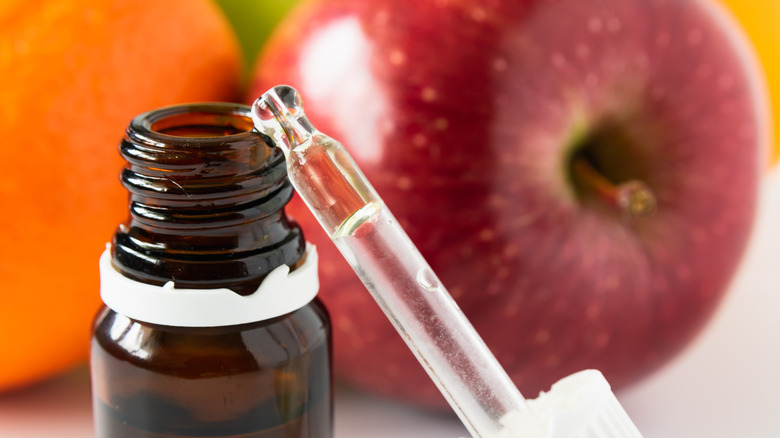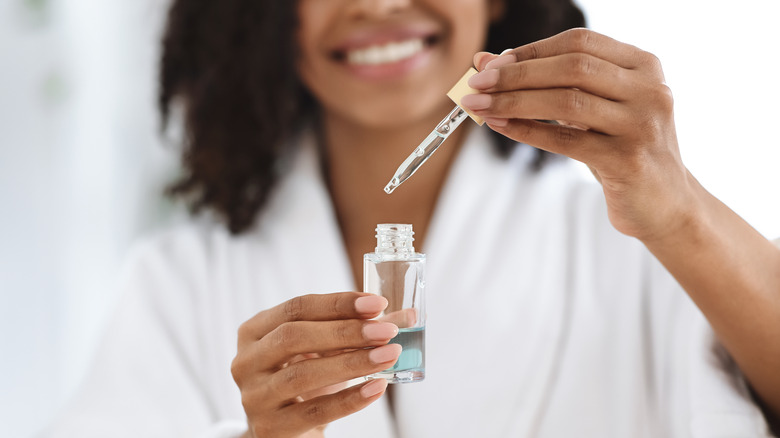Alpha Hydroxy Acids Are The Smoothing Ingredient Your Skincare Routine Has Been Missing
We may receive a commission on purchases made from links.
Some of the most popular skincare products contain lactic or glycolic acid, citric acid, and similar ingredients. These compounds belong to a class of chemicals called alpha-hydroxy acids (AHAs) and can tackle various skin problems, from wrinkles and fine lines to acne. Their role is to exfoliate the skin and boost collagen synthesis, leading to a more youthful complexion.
According to a 2010 review published in Clinical, Cosmetic, and Investigational Dermatology, AHAs can slow down aging and repair sun-damaged skin. Over time, they boost hyaluronic acid levels and epidermal thickness, which may improve skin texture. However, these chemicals carry potential risks and shouldn't be used for long periods. In some cases, they can make the skin more sensitive to sunlight and cause hyperpigmentation.
For example, you can put glycolic acid on your face to remove dead skin cells and get your glow back. According to the 2010 review, this compound not only exfoliates the skin but also stimulates collagen production. The downside is that it may cause dark spots in response to sunlight and other sources of ultraviolet radiation. Also, not all AHAs are created equal — and each has distinct benefits and drawbacks.
Alpha-hydroxy acids might be the key to glowing skin
Alpha-hydroxy acids are chemicals derived from natural or synthetic sources. The most common ones include lactic, glycolic, malic, tartaric, and citric acid explains a 2018 review published in the journal Molecules. For example, malic acid occurs naturally in apples, whereas citric acid comes from grapefruit, oranges, lemons, and other citrus fruits. These compounds can be applied topically to treat age spots, acne, seborrhea, and other skin problems. Some manufacturers also use AHAs in shampoos and conditioners.
These chemicals are more or less effective, depending on their concentration and exposure time. Glycolic acid is generally more irritating to the skin than lactic acid and should be used in lower doses, note the researchers. However, all AHAs can cause some irritation and mild burning due to their acidity, reports a 1997 review featured in Current Drug Therapy. Leaving these aspects aside, alpha-hydroxy acids are proven to reduce the signs of aging and improve skin appearance.
Celebrity dermatologist Dennis Gross recommends using vitamin A and lactic acid together. As it turns out, this combo locks in moisture and improves antioxidant absorption without causing irritation. Lactic acid exfoliates and moisturizes the skin, whereas vitamin C fights oxidative stress. Other experts found that AHAs can improve skin color, elasticity, and thickness, according to Current Drug Therapy.
AHAs are generally safe but should be used with caution
Alpha-hydroxy acids can increase skin sensitivity to sunlight and cause irritation. In rare cases, they may lead to chemical burns, dermatitis, blisters, and changes in skin color, but these side effects are more likely to occur in those using high concentrations of AHAs. For this reason, it's best to choose a product with no more than 10% AHAs and a pH of at least 3.5. Also, consider your skin type and the problem you want to address.
For example, glycolic acid is more irritating than other alpha-hydroxy acids and should be used with caution by people with sensitive skin. A gentler option is either malic or mandelic acid, but lactic acid should be pretty safe, too. Apart from that, it's essential to protect your skin from sunlight while using these compounds. The authors of the study published in Current Drug Therapy recommend wearing a hat and applying sunscreen before leaving home. Ideally, use mineral sunscreen rather than chemical sunscreen because it's less irritating.
According to Clinical, Cosmetic, and Investigational Dermatology, products with a high concentration of AHAs are more effective at treating sun-damaged skin and other problems. Still, they can be harsh on the skin. Your best bet is to only use them as needed and choose a gentler formula for everyday use. A good example is Paula's Choice Skin Perfecting 8% AHA Gel Exfoliant, which is gentle enough to be applied twice daily.

